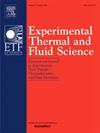t型结微通道中非牛顿两相泰勒流的流体流动和传质实验研究
IF 2.8
2区 工程技术
Q2 ENGINEERING, MECHANICAL
Experimental Thermal and Fluid Science
Pub Date : 2024-12-11
DOI:10.1016/j.expthermflusci.2024.111391
引用次数: 0
摘要
系统地研究了液-液两相泰勒流在微通道中的流动特性和传质机理。以氢氧化钠去离子水和乙酸硅油为实验介质。研究结果表明,对称段塞流主要表现为内部循环,而随着长度的增加,二次循环发生在头部和尾部。然而,由于径向对称循环的限制,大量的溶质留在中轴线上。此外,段塞流末端的帽状结构阻碍了液膜与连续相之间的传质。我们观察到,随着乙酸浓度的增加,整个通道的传质系数从约0.031 /s降低到0.01 1/s。相反,氢氧化钠浓度的增加减少了整个通道的传质距离和传质时间,从而增加了整个微通道的传质系数。此外,水粘度的增加导致油相周围的液膜变厚,导致二次循环,液膜与油相主体之间的传质增强,传质系数从约0.01 1/s提高到0.028 1/s。此外,在低流速下,水表面张力的变化显著改变了微通道内液-液两相的流型,从而影响了传质过程,传质系数最高可达0.045 1/s。通过理论分析,导出了对称段塞流形态下微通道内的传质系数方程。此外,我们还利用数据拟合方法建立了传质过程流动模式的半经验预测模型,这是仅使用理论模型难以解决的问题。将计算结果与实验数据进行比较,验证了模型的正确性,预测精度在30%以内,成功地预测了复杂两相条件下的传质系数。本文章由计算机程序翻译,如有差异,请以英文原文为准。
Experimental study on fluid flow and mass transfer of non-Newtonian two-phase Taylor flow in a T-junction microchannel
The study systematically investigates the flow characteristics and mass transfer mechanism of liquid–liquid two-phase Taylor flow in microchannel. Deionized water with sodium hydroxide and silicone oil with acetic acid are used as the experimental media. Our findings reveal that symmetric slug flow exhibits the main internal circulation, while secondary circulation occurs in the head and tail as the length increases. However, due to the restriction of radial symmetry circulation, a significant amount of solute remains in the central axis. Moreover, the cap-like structure at the end of the slug flow hinders mass transfer between the liquid film and the continuous phase. We observe that the mass transfer coefficient of the entire channel decreases from about 0.03 1/s to 0.01 1/s with an increase in acetic acid concentration. Conversely, an increase in sodium hydroxide concentration decreases the mass transfer distance and time of the whole channel, thereby increasing the mass transfer coefficient throughout the microchannel. Furthermore, an increase in water viscosity results in a thicker liquid film around the oil phase, leading to secondary circulation and enhanced mass transfer between the liquid film and the main body of the oil phase, the mass transfer coefficient improved from approximately 0.01 1/s to 0.028 1/s. Additionally, changes in water surface tension significantly alter the liquid–liquid two-phase flow pattern in the microchannel at low flow velocities, consequently affecting the mass transfer process, the mass transfer coefficient can reach up to 0.045 1/s. We derive the equation for the mass transfer coefficient in microchannels under the shape of symmetric slug flow through theoretical analysis. Furthermore, we develop semi-empirical prediction models using data fitting methods for flow patterns of the mass transfer process, which are challenging to solve using theoretical models alone. By comparing the computational results with experimental data, we validated our model, achieving an accuracy within 30 %, successfully predicting the mass transfer coefficients under complex two-phase conditions.
求助全文
通过发布文献求助,成功后即可免费获取论文全文。
去求助
来源期刊

Experimental Thermal and Fluid Science
工程技术-工程:机械
CiteScore
6.70
自引率
3.10%
发文量
159
审稿时长
34 days
期刊介绍:
Experimental Thermal and Fluid Science provides a forum for research emphasizing experimental work that enhances fundamental understanding of heat transfer, thermodynamics, and fluid mechanics. In addition to the principal areas of research, the journal covers research results in related fields, including combined heat and mass transfer, flows with phase transition, micro- and nano-scale systems, multiphase flow, combustion, radiative transfer, porous media, cryogenics, turbulence, and novel experimental techniques.
 求助内容:
求助内容: 应助结果提醒方式:
应助结果提醒方式:


